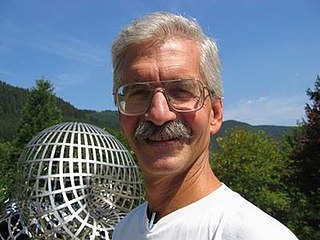Related Research Articles

Discrete geometry and combinatorial geometry are branches of geometry that study combinatorial properties and constructive methods of discrete geometric objects. Most questions in discrete geometry involve finite or discrete sets of basic geometric objects, such as points, lines, planes, circles, spheres, polygons, and so forth. The subject focuses on the combinatorial properties of these objects, such as how they intersect one another, or how they may be arranged to cover a larger object.
In mathematics, Diophantine geometry is the study of Diophantine equations by means of powerful methods in algebraic geometry. By the 20th century it became clear for some mathematicians that methods of algebraic geometry are ideal tools to study these equations. Diophantine geometry is part of the broader field of arithmetic geometry.

Nicholas Michael Katz is an American mathematician, working in arithmetic geometry, particularly on p-adic methods, monodromy and moduli problems, and number theory. He is currently a professor of Mathematics at Princeton University and an editor of the journal Annals of Mathematics.

In mathematics, arithmetic geometry is roughly the application of techniques from algebraic geometry to problems in number theory. Arithmetic geometry is centered around Diophantine geometry, the study of rational points of algebraic varieties.
Joseph Hillel Silverman is a professor of mathematics at Brown University working in arithmetic geometry, arithmetic dynamics, and cryptography.
The Morgan Prize is an annual award given to an undergraduate student in the US, Canada, or Mexico who demonstrates superior mathematics research. The $1,200 award, endowed by Mrs. Frank Morgan of Allentown, Pennsylvania, was founded in 1995. The award is made jointly by the American Mathematical Society, the Mathematical Association of America, and the Society for Industrial and Applied Mathematics. The Morgan Prize has been described as the highest honor given to an undergraduate in mathematics.

Algebraic combinatorics is an area of mathematics that employs methods of abstract algebra, notably group theory and representation theory, in various combinatorial contexts and, conversely, applies combinatorial techniques to problems in algebra.
Heiko Harborth is Professor of Mathematics at Braunschweig University of Technology, 1975–present, and author of more than 188 mathematical publications. His work is mostly in the areas of number theory, combinatorics and discrete geometry, including graph theory.

Barry Charles Mazur is an American mathematician and the Gerhard Gade University Professor at Harvard University. His contributions to mathematics include his contributions to Wiles's proof of Fermat's Last Theorem in number theory, Mazur's torsion theorem in arithmetic geometry, the Mazur swindle in geometric topology, and the Mazur manifold in differential topology.
Lawrence David Guth is a professor of mathematics at the Massachusetts Institute of Technology.

Richard Paul Winsley Thomas is a British mathematician working in several areas of geometry. He is a professor at Imperial College London. He studies moduli problems in algebraic geometry, and ‘mirror symmetry’—a phenomenon in pure mathematics predicted by string theory in theoretical physics.
Michel Las Vergnas was a French mathematician associated with Pierre-and-Marie-Curie University in Paris, and a research director emeritus at the Centre national de la recherche scientifique.

Ron Yehuda Donagi is an American mathematician, working in algebraic geometry and string theory.
Sheldon H. Katz is an American mathematician, specializing in algebraic geometry and its applications to string theory.

June E Huh is an American mathematician who is currently a professor at Princeton University. Previously, he was a professor at Stanford University. He was awarded the Fields Medal and a MacArthur Fellowship in 2022. He has been noted for the linkages that he has found between algebraic geometry and combinatorics.

Jennifer Shyamala Sayaka Balakrishnan is an American mathematician known for leading a team that solved the problem of the "cursed curve", a Diophantine equation that was known for being "famously difficult". More generally, Balakrishnan specializes in algorithmic number theory and arithmetic geometry. She is a Clare Boothe Luce Professor at Boston University.
Edray Herber Goins is an American mathematician. He specializes in number theory and algebraic geometry. His interests include Selmer groups for elliptic curves using class groups of number fields, Belyi maps and dessins d'enfant.
Melody Tung Chan is an American mathematician and violinist who works as Associate Professor of Mathematics at Brown University. She is a winner of the Alice T. Schafer Prize and of the AWM–Microsoft Research Prize in Algebra and Number Theory. Her research involves combinatorial commutative algebra, graph theory, and tropical geometry.

Federico Ardila is a Colombian mathematician and DJ who researches combinatorics and specializes in matroid theory. Ardila graduated from MIT with a B.Sc. in mathematics in 1998 and obtained a Ph.D. in 2003 under the supervision of Richard P. Stanley in the same institution. Ardila is currently a professor at the San Francisco State University and additionally holds an adjunct position at the University of Los Andes in Colombia.
In arithmetic geometry, the uniform boundedness conjecture for rational points asserts that for a given number field and a positive integer , there exists a number depending only on and such that for any algebraic curve defined over having genus equal to has at most -rational points. This is a refinement of Faltings's theorem, which asserts that the set of -rational points is necessarily finite.
References
- ↑ Eric Katz (2005-07-15). "Formalism for Relative Gromov-Witten Invariants" . Retrieved May 24, 2019.
- ↑ "Combinatorics and more". 14 August 2015.
- ↑ "A Path Less Taken to the Peak of the Math World". Quanta Magazine . Retrieved 2017-07-01.
- ↑ "Hodge theory of matroids" (PDF), Notices of the AMS , retrieved 2017-07-03
- ↑ Baker, Matt. "Hodge Theory and Combinatorics" (PDF). 2017 AMS Current Events Bulletin. Retrieved 2017-07-04.
- ↑ Katz, Eric; Rabinoff, Joseph; Zureick-Brown, David (2016), Diophantine and tropical geometry, and uniformity of rational points on curves, arXiv: 1606.09618 , Bibcode:2016arXiv160609618K
- ↑ Eric Katz at the Mathematics Genealogy Project